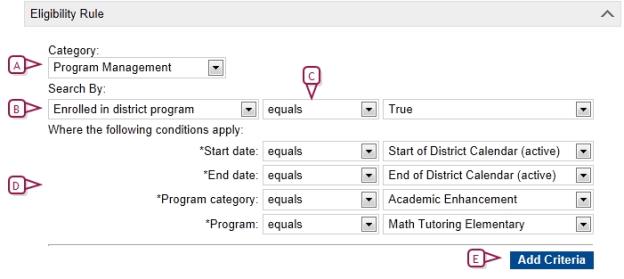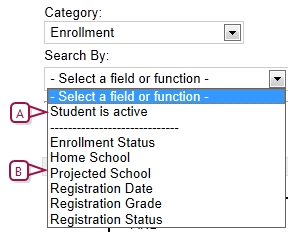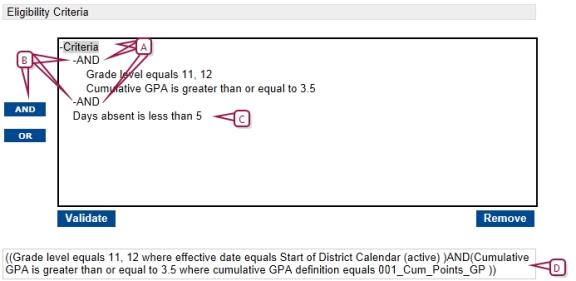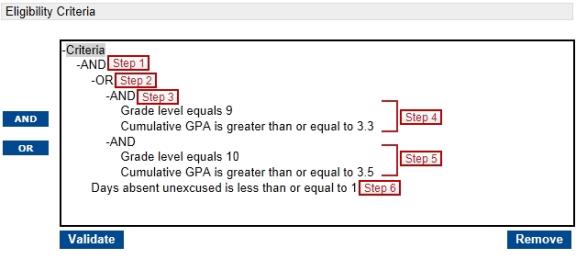Open topic with navigation
Eligibility rules
PowerSchool SMS enables you to construct eligibility rules that specify the criteria students must meet to qualify for:
|
=
|
Scheduling: Class and homeroom constraints |
|
=
|
Manage queues and programs |
Eligibility rules are created using eligibility control. This control is available to many features of PowerSchool SMS, such as Attendance, Demographics, Grading, Program Management, and so on.
Eligibility control
The eligibility control [Figure 172] is made up of:
|
=
|
Statement builder - In the case of honor rolls, a statement describes what the student needs to have achieved to qualify for an honor roll; for example, a GPA of 3.5 or a total of less than 5 absences in a specific time frame. The statement builder is a collection of fields known as Search By sets that you use to construct the statement. |
|
=
|
Eligibility criteria - Eligibility criteria are one or many statements plus the logical operators (AND/OR) that connect the statements. The eligibility criteria section is where you add the statements and their logical operators. |
Figure 172: Eligibility control

Statement builder
In each category (such as, Grading, Attendance), you will find all the existing properties in the database that could be relevant to calculating eligibility for that particular category.
The statement builder [Figure 173] has three sections:
|
=
|
A primary Search By statement used to construct the main search statement. |
|
=
|
Where clauses for functions that allow you to further limit the search. |
Depending on the category you select you can select either a field or a function [Figure 174]. The options available for specifying a criteria depends on whether you select a field or a function.
Some fields include an additional Search By set below the first [Figure 175], which allows you to search for specific information related to the selected field. For example, if you select a setup list, such as Ethnicity, an additional dropdown allows you to select another left term, such as description or code, and specify an operator and right term; for example, Ethnicity Description equals Asian.
Note: For best results, before calculating eligibility, make sure student data is complete and correct. When eligibility rule criteria is processed that references a field that is empty, it evaluates the criteria as false unless it uses the is empty operator. For example, if the student's Date of Birth is empty:
|
=
|
The age is empty criteria would evaluate as true. |
|
=
|
The age does not equal 12 criteria would evaluate as false. |
For example [Figure 173], if you select the category Program Management, then choose Enrolled in a district program, a where clause displays, enabling you to select a start and end dates, program category and program.
The eligibility rule as a whole is displayed in the list box in the Eligibility Criteria section [Figure 176]. This list box is organized in a tree structure, similar to the folders on a computer. The branches of this tree are called nodes.
Figure 173: Statement builder

|
B
|
Search By statement. The Search By section in the statement builder is made up of a term to search by, an operator, and a value. |
|
C
|
Operators used to build criteria such as equals, is greater than or equal to, contains, etc. |
|
D
|
Where clauses for some statements |
|
E
|
Add Criteria: Click to add statements to the Eligibility Criteria |
Table 29: Eligibility categories
|
Category
|
Description
|
|
Attendance
|
Use to define statements related to student total daily attendance by value or percentage. This category includes different functions for each valid combination of Absent, Tardy, or Present and Excused or Unexcused.
|
|
Demographics
|
Use to define statements related to student basic demographics data (i.e., fields from the Personal page), such as gender, federal ethnic category, and home language. This category includes functions for age and grade level as of a specific date.
|
|
Enrollment
|
Use to define statements related to student enrollment status. This category includes a function for active/inactive status as of a specific date.
|
|
Grading
|
Use to define statements related to student grades, credits, and grade point averages. This category includes functions for various GPAs and grades.
|
|
Health
|
Use to define statements related to student health records. This category includes functions for health examination and immunization compliance.
|
|
Historical
|
Use to define statements related to student transcript data. This category includes functions for historical attendance, historical grades, historical credits, and historical grade point averages.
|
|
Program Management
|
Use to define statements related to student program management records. This category includes functions for program enrollment, received program documents, and program grade.
|
|
Scheduling
|
Use to define statements related to student scheduling information.
|
|
Student Behavior
|
Use to define statements related to student behavior. This category includes functions for the number of incidents for an Event/Concern category as of a specific date.
|
|
Test Management
|
Use to define statements related to student test results, as captured in the Test Management feature area. This category includes various functions for scores on alpha and numeric tests, skills, and subtests.
|
|
Test Scores
|
Use to define statements related to student test scores, as captured in the Legacy Test Scores feature area.
|
Figure 174: Fields and functions

|
A
|
Field: A field is any single piece of data stored in the database, such as a student's gender. |
|
B
|
Function: A function is used to construct statements about complex data that require you to specify limiting or where clauses. When you select a function, a section called Where the following conditions apply appears below the Search By section [Figure 173]. Functions that contain where clauses include any of the parameters, see [Table 30]. |
Table 30: Function parameters
| Parameter |
Description |
| Action Category |
Action categories defined in the Behavior Action Category setup list. |
| Action Step |
Includes or excludes specific action steps in the criteria.
From the dropdown, select Include All, Include Selected, Exclude Selected. If you select Include Selected or Exclude Selected, click the <n> Records Selected link to search for and select the action steps to include or exclude.
|
| Action Step Category |
Action step categories defined in the Behavior Action Step Category setup list.
|
| Actions |
Includes or excludes specific actions in the criteria.
From the dropdown, select Include All, Include Selected, Exclude Selected. If you select Include Selected or Exclude Selected, click the <n> Records Selected link to search for and select the actions to include or exclude.
|
| Alpha Score Type |
The alpha score type from a list of all alpha score types set up at the test level for the selected test. |
| Attendance Code |
Daily attendance codes.
If you are defining the rule at the district, the list includes attendance codes defined at any school in the district. If you are defining the rule at a school, the list only includes attendance codes defined at that school.
|
| Courses |
Includes or excludes specific courses in the criteria.
From the dropdown, select Include All, Include Selected, Exclude Selected. If you select Include Selected or Exclude Selected, click the <n> Records Selected link to search for and select the courses to include or exclude.
Note: The course search is based on internal course IDs, which change in each calendar. In the planning calendar, the course search is based on the courses in the active calendar. After you run YEP, you must re-create rules that use this parameter in the new active calendar.
|
| Cumulative GPA Definition |
Cumulative GPA definitions.
If you are defining the rule at the district, the list includes Cumulative GPA definitions defined at any school in the district. If you are defining the rule at a school, the list includes only those definitions defined at that school.
|
| Current Year GPA Definition |
Current-year GPA definitions.
If you are defining the rule at the district, the list includes current-year GPA definitions defined at any school in the district. If you are defining the rule at a school, the list includes only those definitions defined at that school.
|
| Effective Date |
The date on which to consider the criteria. See [Table 31].
|
| End Date |
The end of a date range. See [Table 31] |
| End of Test Date Range |
The last date in the range that the student’s test date must fall. See [Table 31] |
| Examination Type |
Examination types defined in the Health Examination Types setup list. |
| Grade Item |
If you are defining the rule at the district, the list includes all grade items defined at any school in the district. If you are defining the rule at a school, the list includes only those grade items defined at that school.
|
| Incident Category |
Incident categories. |
| Incident Severity |
Includes or excludes specific incident severities in the criteria.
In the dropdown, select Include All, Include Selected, Exclude Selected. If you select Include Selected or Exclude Selected, click the <n> Records Selected link to search for and select the incident severities to include or exclude.
|
| Letter Grade |
The alpha value that defines the letter grade students must have achieved to satisfy the criteria. |
| Maximum Grade |
The numeric value that defines the maximum grade students can have achieved to satisfy the criteria. |
| Minimum Grade |
The numeric value that defines the minimum grade students must have achieved to satisfy the criteria. |
| Maximum Miles From School |
The numeric number that defines the farthest distance from the program a student can live. |
| Minimum Miles From School |
The numeric number that defines the nearest distance from the program a student can live. |
| Numeric Score Type |
The numeric score type from a list of all numeric score types set up at the test level for the selected test. |
| Program |
Programs that were set up at the district in the selected program category. |
| Program Category |
The program category. |
| Program Document |
Program documents required for the selected program. |
| Program Session |
Program sessions defined for the selected program at the district. |
| Skill Name |
The skills from a list of defined skills. |
| Start Date |
The beginning of a date range. See [Table 31] |
| Start of Test Date Range |
The first date in the range that the student’s test date must fall. See [Table 31] |
| Subtest Name |
The subtest from a list of defined subtests. |
| Test Name |
The test name defined in test definitions.
If you are defining the rule at the district, the list includes test definitions defined at any school in the district. If you are defining the rule at a school, the list includes only those tests defined at that school.
|
Table 31: Date options
Note: If the eligibility rule will be available in multiple calendars, carefully consider which date to select for the rule:
| Option
|
Description |
| Fixed Date |
The rule is evaluated based on the specified date, e.g., September 1, 2006.
|
| Fixed Month and Day |
The rule is evaluated based on the specified month and day and uses the working calendar year, e.g., September 1 uses 2006 in the active calendar and 2007 in the planning calendar.
|
| End of District Calendar (active)
|
The rule is evaluated based on the last day of the district active calendar, regardless of which calendar is active when the rule is run.
|
| End of District Calendar (planning) |
The rule is evaluated based on the last day of the district planning calendar, regardless of which calendar is active when the rule is run.
|
| End of Working Calendar |
The rule is evaluated based on the last day of the district calendar for the calendar that is active when the rule is run. |
| Start of District Calendar (active)
|
The rule is evaluated based on the first day of the district active calendar, regardless of which calendar is active when the rule is run.
|
| Start of District Calendar (planning)
|
The rule is evaluated based on the first day of the district planning calendar, regardless of which calendar is active when the rule is run.
|
| Start of Working Calendar
|
The rule is evaluated based on the first day of the district calendar for the calendar that is active when the rule is run.
|
| Today
|
The rule is evaluated based on the current date in the active calendar. |
Figure 175: Additional search criteria

Figure 176: Eligibility criteria

|
A
|
Node - A node can be the Criteria text at the top of the Eligibility Criteria list box or a logical operator within the list box. |
|
B
|
Logical operators - If you have more than one statement in the your rule, you must add logical operators to group them meaningfully. |
For example, if students are required to meet all the criteria in your rule, the first node under Criteria should be AND; all the statements would then hang off that node. If, on the other hand, students are only required to meet one out of a list of criteria, the first node should be OR. Additional nodes can be added to allow a combination of these operators.
To add logical operators, click the node to which you want to add the operator and then click the AND or OR button. If required, you can drag the statements to the appropriate node. You can also drag whole nodes to different locations in the list box, or remove statements completely.
Note: When dragging a statement or operator, make sure the cursor is directly above the node before releasing it.
|
C
|
Statement - When you construct a statement and click Add Criteria, the statement is added below the selected node, or to the bottom of the rule if a node was not selected. |
|
D
|
Completed rule - The complete rule displays after the rule is saved. |
Eligibility rule example
In the following example [Figure 177], a single honor roll is used for multiple grade levels. Students in grades 9 must have a weighted cumulative GPA of 3.3 or higher; students in grades 10 must have a weighted cumulative GPA of 3.5 or higher. For both grade levels, students may have no more than one unexcused absence for the year-to-date.
|
1
|
Under Eligibility Criteria, click AND. This allows you to specify that there are multiple statements in the rule (e.g., grade level and GPA, plus attendance). |
|
2
|
In the tree, select AND and click OR. This adds OR to the rule, which allows you to create one set of rules for one grade level, and another for a different grade level. |
|
3
|
In the tree, select OR and click AND. This adds AND as a branch, where you can define multiple criteria for one variation of the honor roll. |
|
4
|
Add the grade level and GPA criteria for one grade level as follows: |
|
a
|
From the Category dropdown, select Demographics. |
|
b
|
In the first search by set, construct the following statement: Grade level equals 9.In the second search by set, construct the following where clause: Effective date equals today. |
|
d
|
From the Category dropdown, select Grading. |
|
e
|
In the first search by set, construct the following statement: Cumulative GPA is greater than or equal to 3.3. |
|
f
|
In the second search by set, define the cumulative GPA definition such as: Cumulative GPA Definition equals Weighted Cumulative GPA. |
|
h
|
Click and drag the two statements to the AND item.
Note: You must drag and drop the statement directly on top of the AND statement to move it. |
|
5
|
Repeat step 4 for grade 10 with a GPA of 3.5. |
|
6
|
Add the attendance criteria for one grade level as follows: |
|
a
|
From the Category dropdown, select Attendance. |
|
b
|
In the first search by set, construct the following statement: Days Absent Unexcused is less than or equal to 1. |
|
c
|
In the second search by set, construct the following where clause: Start date equals start of district calendar (active). |
|
d
|
In the second search by set, construct the following where clause: End date equals today. |
Figure 177: Eligibility rule example


www.powerschool.com
Tel: 866-434-6276
Email: smssupport@powerschool.com
Copyright 2015-2016 PowerSchool Group LLC and/or its affiliate(s). All rights reserved. All trademarks are either owned or licensed by PowerSchool Group LLC and/or its affiliates.







